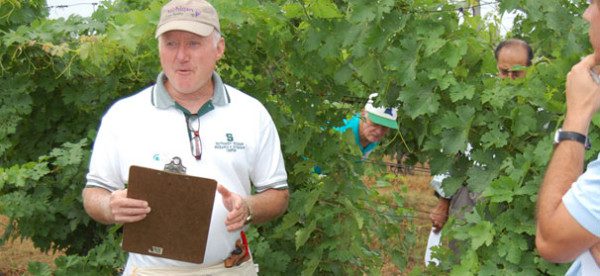

Oct 1, 2012Are your grapes ready for cordon renewal?
Do your grapes need a cordon replacement? You know, that horizontal arm that is trained around a trellis wire that your grape vines grow off from?
Don’t worry, said Tom Zabadal, a researcher with Michigan State University. You’re not alone if you aren’t sure you need to renew your cordons.
Cordons have an advantage, Zabadal said, in that they allow for a semi-permanent part of the vine that supports fruiting buds or spurs. Having this support reduces the amount of tying that is needed annually. This can serve to reduce labor costs.
Cordons can also offer growers an orderly annual renewal zone that can help with shoot positioning, leaf removal and more. This also opens the door to mechanized pruning, another labor-saving tool.
But, Zabadal said, there are some disadvantages to cordons that growers need to be aware of. Quite often, as they mature, cordons get barren spaces where the shoots get limited, which decreases production from the vine. It is similar to high-density fruit tree plantings, where there is too much wood and not enough fruiting plant.
Cordons can also be a reservoir for disease and other issues within the plant, Zabadal said. Diseased cordons can cause an otherwise healthy plant to become unproductive, or lead to the demise of an entire plant – or worse, a vineyard.
Older cordons often produce an abundance of base shoots, as well. This leads to an excessive amount of shoot density, resulting in poor fruit set and extra labor costs, he said.
“The solution is that we should be replacing our cordons frequently enough to avoid these disadvantages,” Zabadal said. “But the problem here is human nature. We often think we have too much work to do this year, so we put it off. The reality is, we’re only hurting ourselves when we do.”
Cordon removal
Growers should consider replacing cordons on a 10-year rotating schedule, Zabadal said. He suggests cutting them out with a big pair of loppers, or using a reciprocating saw for large, well-established cordons.
“I like using a saw with a Porter Cable Pruning Blade,” he said. “The blade is designed for this kind of work and won’t cut through trellis wires.”
A good time to replace cordons is when a vineyard experiences a crop failure due to a winter injury or spring freeze, Zabadal said. It is a great time to renew the vineyard from the ground up.
Select a cane for use as the new cordon and wrap it no more than one revolution around a wire, Zabadal said.
“You may not want to wrap the cane around the wire at all,” he said. “I’ve had great success using a rubber-based tie to secure the cane to the wire.”
He also suggested use of crimped wire for added support, especially for fruit-bearing cordons, as it makes the use of ties more efficient. In his tests, it has also made pruning more efficient.
“The most important thing about cordon renewal is that it isn’t perfect,” Zabadal said. “No one has totally perfected it yet, so don’t be afraid to try new things.”
By Derrek Sigler, Assistant Editor














